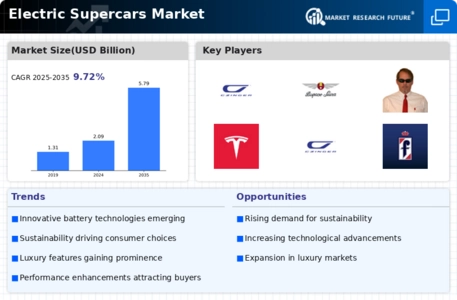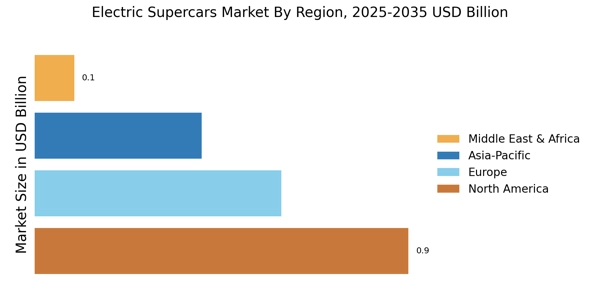Government Incentives and Regulations
Government incentives and regulations play a crucial role in shaping the Electric Supercars Market. Many governments are implementing policies aimed at reducing carbon emissions and promoting electric vehicle adoption. These initiatives often include tax breaks, rebates, and grants for electric vehicle purchases, which can significantly lower the cost for consumers. Additionally, stricter emissions regulations are pushing manufacturers to invest in electric supercars as a viable alternative to traditional combustion engines. As a result, the market is witnessing an influx of new models that meet these regulatory standards. The combination of financial incentives and regulatory pressures is likely to accelerate the transition towards electric supercars, making them more accessible and appealing to consumers.
Rising Demand for High-Performance Vehicles
The Electric Supercars Market is experiencing a notable surge in demand for high-performance vehicles. Consumers are increasingly seeking vehicles that not only offer speed and agility but also align with modern sustainability values. This trend is reflected in the growing sales figures, with electric supercars projected to account for a significant share of the luxury car market by 2026. The allure of electric supercars lies in their ability to deliver exceptional performance while minimizing environmental impact. As manufacturers innovate to enhance battery technology and powertrains, the performance metrics of electric supercars continue to improve, attracting a broader audience. This rising demand is likely to drive investments in research and development, further propelling the Electric Supercars Market forward.
Emerging Market Opportunities in Developing Regions
Emerging market opportunities in developing regions are presenting new avenues for growth within the Electric Supercars Market. As economies in these regions expand, there is a rising middle class with increasing disposable income, leading to a greater interest in luxury goods, including high-performance vehicles. Additionally, the growing awareness of environmental issues is prompting consumers in these markets to consider electric supercars as a viable option. Manufacturers are beginning to explore these markets, tailoring their offerings to meet local preferences and regulatory requirements. The potential for growth in developing regions is substantial, as the demand for electric supercars is expected to rise, driven by both economic factors and a shift towards sustainable transportation solutions.
Shifting Consumer Preferences Towards Sustainability
Shifting consumer preferences towards sustainability are significantly influencing the Electric Supercars Market. As awareness of environmental issues grows, consumers are increasingly prioritizing eco-friendly options in their purchasing decisions. This shift is evident in the luxury automotive sector, where buyers are seeking vehicles that not only provide high performance but also contribute to a sustainable future. Electric supercars, with their zero-emission capabilities, are well-positioned to meet this demand. Market Research Future indicates that a substantial percentage of luxury car buyers are willing to pay a premium for electric vehicles that align with their values. This trend is likely to drive manufacturers to focus on sustainability in their designs and marketing strategies, further enhancing the appeal of electric supercars.
Technological Innovations in Battery and Charging Infrastructure
Technological innovations in battery and charging infrastructure are pivotal to the growth of the Electric Supercars Market. Advances in battery technology, such as solid-state batteries, are enhancing energy density and reducing charging times, which are critical factors for performance-oriented vehicles. Furthermore, the expansion of fast-charging networks is addressing range anxiety, a common concern among potential electric supercar buyers. As charging infrastructure becomes more robust and widespread, it is expected to facilitate greater adoption of electric supercars. The integration of smart technologies, such as vehicle-to-grid systems, is also emerging, allowing electric supercars to contribute to energy management. These innovations are likely to create a more favorable environment for the Electric Supercars Market, encouraging both manufacturers and consumers to embrace electric performance vehicles.


















Leave a Comment